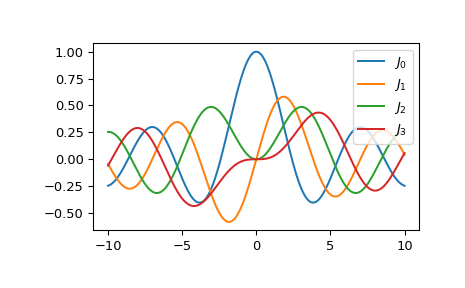scipy.special.jv#
- scipy.special.jv(v, z, out=None) = <ufunc 'jv'>#
Bessel function of the first kind of real order and complex argument.
- Parameters:
- varray_like
Order (float).
- zarray_like
Argument (float or complex).
- outndarray, optional
Optional output array for the function values
- Returns:
- Jscalar or ndarray
Value of the Bessel function, \(J_v(z)\).
See also
jve\(J_v\) with leading exponential behavior stripped off.
spherical_jnspherical Bessel functions.
j0faster version of this function for order 0.
j1faster version of this function for order 1.
Notes
For positive v values, the computation is carried out using the AMOS [1] zbesj routine, which exploits the connection to the modified Bessel function \(I_v\),
\[ \begin{align}\begin{aligned}J_v(z) = \exp(v\pi\imath/2) I_v(-\imath z)\qquad (\Im z > 0)\\J_v(z) = \exp(-v\pi\imath/2) I_v(\imath z)\qquad (\Im z < 0)\end{aligned}\end{align} \]For negative v values the formula,
\[J_{-v}(z) = J_v(z) \cos(\pi v) - Y_v(z) \sin(\pi v)\]is used, where \(Y_v(z)\) is the Bessel function of the second kind, computed using the AMOS routine zbesy. Note that the second term is exactly zero for integer v; to improve accuracy the second term is explicitly omitted for v values such that v = floor(v).
Not to be confused with the spherical Bessel functions (see
spherical_jn).References
[1]Donald E. Amos, “AMOS, A Portable Package for Bessel Functions of a Complex Argument and Nonnegative Order”, http://netlib.org/amos/
Examples
Evaluate the function of order 0 at one point.
>>> from scipy.special import jv >>> jv(0, 1.) 0.7651976865579666
Evaluate the function at one point for different orders.
>>> jv(0, 1.), jv(1, 1.), jv(1.5, 1.) (0.7651976865579666, 0.44005058574493355, 0.24029783912342725)
The evaluation for different orders can be carried out in one call by providing a list or NumPy array as argument for the v parameter:
>>> jv([0, 1, 1.5], 1.) array([0.76519769, 0.44005059, 0.24029784])
Evaluate the function at several points for order 0 by providing an array for z.
>>> import numpy as np >>> points = np.array([-2., 0., 3.]) >>> jv(0, points) array([ 0.22389078, 1. , -0.26005195])
If z is an array, the order parameter v must be broadcastable to the correct shape if different orders shall be computed in one call. To calculate the orders 0 and 1 for an 1D array:
>>> orders = np.array([[0], [1]]) >>> orders.shape (2, 1)
>>> jv(orders, points) array([[ 0.22389078, 1. , -0.26005195], [-0.57672481, 0. , 0.33905896]])
Plot the functions of order 0 to 3 from -10 to 10.
>>> import matplotlib.pyplot as plt >>> fig, ax = plt.subplots() >>> x = np.linspace(-10., 10., 1000) >>> for i in range(4): ... ax.plot(x, jv(i, x), label=f'$J_{i!r}$') >>> ax.legend() >>> plt.show()
